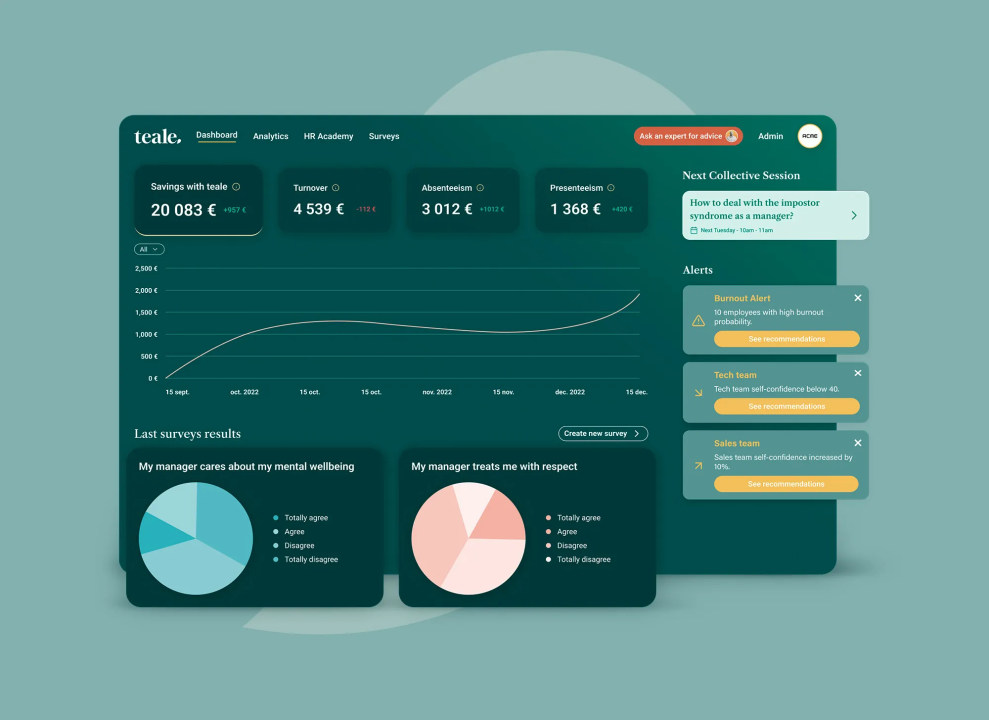In today’s data-driven world, the ability to make informed decisions quickly is crucial for businesses across various industries. A well-designed dashboard serves as the central hub for data visualization, allowing users to access key metrics and insights at a glance. This article explores how a
UI/UX design company can craft intuitive dashboards that empower organizations to make better, data-driven decisions.
Understanding the Importance of Intuitive Dashboards
A dashboard is a visual representation of key performance indicators (KPIs), metrics, and data points relevant to a specific objective or business process. It consolidates information from multiple sources into a single interface, allowing users to monitor performance and track progress efficiently.
The Role of Dashboards in Decision Making
Dashboards play a pivotal role in decision-making processes by providing users with real-time data and insights. An intuitive dashboard can help organizations:
- Quickly Identify Trends: By visualizing data in real-time, users can spot trends and patterns that inform strategic decisions.
- Improve Collaboration: Dashboards facilitate communication among team members by presenting a unified view of data, enabling better collaboration.
- Enhance User Experience: A well-designed dashboard enhances user experience, making it easier for users to interact with and derive insights from complex data.
The Process of Crafting Intuitive Dashboards
Crafting intuitive dashboards involves a meticulous process that focuses on user needs, effective data visualization, and seamless interactivity. By prioritizing user experience, designers create tools that empower users to derive actionable insights quickly and efficiently.
Step 1: Define User Needs and Objectives
Before a UI/UX design company can start crafting an intuitive dashboard, it is essential to understand the target audience and their specific needs. This involves:
- User Research: Conducting interviews, surveys, and observations to gather insights about user expectations, workflows, and challenges.
- Identifying Key Metrics: Collaborating with stakeholders to identify which KPIs and metrics are most relevant to their goals.
Step 2: Create a User-Centric Design
A user-centric design approach ensures that the dashboard caters to the needs and preferences of its users. Key considerations include:
- Simplicity and Clarity: The dashboard should present information in a clear and straightforward manner, avoiding clutter and unnecessary complexity.
- Intuitive Navigation: Users should be able to navigate the dashboard easily. A logical layout, combined with intuitive icons and labels, enhances usability.
Step 3: Prioritize Data Visualization
Effective data visualization is crucial for conveying complex information in an understandable way. A UI/UX design company employs various techniques to visualize data, including:
- Charts and Graphs: Using bar charts, line graphs, pie charts, and other visual elements to represent data clearly.
- Heatmaps: Highlighting data concentrations and trends using color gradients, making it easy for users to identify key areas of interest.
- Infographics: Combining text and visuals to present information in a visually appealing manner, helping users comprehend data at a glance.
Step 4: Implement Interactive Features
Interactivity enhances user engagement and allows for deeper exploration of data. Interactive features a UI/UX design company may incorporate include:
- Filter Options: Allowing users to filter data by various parameters, such as time periods, regions, or product categories, to gain specific insights.
- Drill-Down Capabilities: Enabling users to click on data points to access more detailed information, helping them understand the context behind the numbers.
- Dynamic Updates: Implementing real-time data updates to ensure users are always looking at the most current information.
Step 5: Conduct Usability Testing
Once the initial design is complete, usability testing is essential to ensure the dashboard meets user expectations. This process involves:
- Gathering Feedback: Conducting tests with actual users to observe how they interact with the dashboard, identifying any pain points or areas for improvement.
- Iterating on Design: Based on user feedback, the design should be refined and optimized to enhance usability and user satisfaction.
The Importance of Collaboration Between UI/UX Design and Development Teams
Effective collaboration between UI/UX design and development teams is crucial for creating seamless and user-friendly digital products. This partnership ensures that design visions are not only aesthetically pleasing but also technically feasible, leading to enhanced user experiences and successful project outcomes.
Integrating Design and Development
For a UI/UX design company to create intuitive dashboards, close collaboration with development teams is essential. This integration ensures that:
- Designs Are Feasible: Development teams provide input on the technical feasibility of design concepts, ensuring that the final product is achievable.
- Consistent User Experience: Collaboration helps maintain a consistent user experience throughout the application, as designers and developers work together to implement the design vision.
Agile Methodology
Many software development companies adopt an agile approach to project management, allowing for iterative design and development processes. This methodology enables:
- Rapid Prototyping: Teams can quickly create and test prototypes, gathering user feedback and making adjustments on the fly.
- Continuous Improvement: Regular feedback loops ensure that the dashboard evolves based on user needs and changing business requirements.
Key Features of an Intuitive Dashboard
A well-crafted dashboard incorporates several key features to enhance usability and functionality. These features include:
Customizable Views
Allowing users to personalize their dashboard experience by selecting which metrics to display and arranging elements according to their preferences. This flexibility enables users to focus on the information most relevant to them.
Alerts and Notifications
Incorporating alerts and notifications helps users stay informed about critical changes in data. For example, users can receive alerts when specific KPIs fall below predetermined thresholds, enabling proactive decision-making.
Mobile Responsiveness
With an increasing number of users accessing dashboards on mobile devices, ensuring that the dashboard is mobile-responsive is vital. A UI/UX design company should design dashboards that adapt seamlessly to various screen sizes and orientations, providing an optimal experience regardless of the device.
Case Studies: Successful Dashboard Implementations
In this section, we explore real-world examples of how a UI/UX design company, in collaboration with a software development company, has successfully crafted intuitive dashboards for various industries. These case studies highlight the tangible benefits of effective dashboard design, showcasing how organizations have enhanced decision-making and improved operational efficiency.
Example 1: Sales Dashboard
A prominent software development company collaborated with a UI/UX design company to create an intuitive sales dashboard for a retail client. By focusing on user needs, the team designed a dashboard that displayed sales performance, customer demographics, and inventory levels in real-time. The interactive features allowed the sales team to filter data by time periods and product categories, leading to informed decision-making that increased sales by 25%.
Example 2: Project Management Dashboard
A UI/UX design company partnered with a
software development company to design a project management dashboard for a tech startup. The dashboard featured customizable views, enabling team members to track project milestones, deadlines, and resource allocation. With drill-down capabilities, users could access detailed project metrics, resulting in improved project efficiency and collaboration among team members.
Conclusion
Crafting intuitive dashboards is a multifaceted process that requires a deep understanding of user needs, effective data visualization techniques, and close collaboration between UI/UX design and development teams. By leveraging the expertise of a UI/UX design company, organizations can create dashboards that empower users to make informed, data-driven decisions. As businesses continue to navigate an increasingly complex data landscape, the role of well-designed dashboards will remain essential in driving success and fostering growth.
Investing in a skilled UI/UX design company is not just about aesthetics; it’s about creating tools that enhance user experience and deliver valuable insights. Whether you’re looking to redesign your existing dashboards or build new ones from scratch, a partnership with a professional UI/UX design company can help you unlock the full potential of your data.





